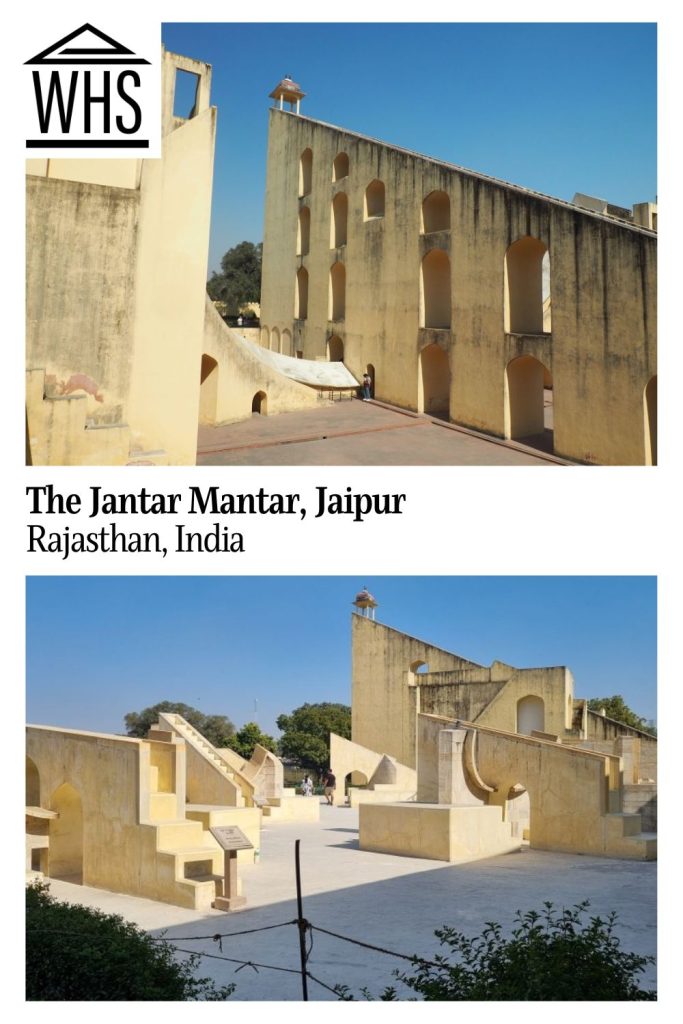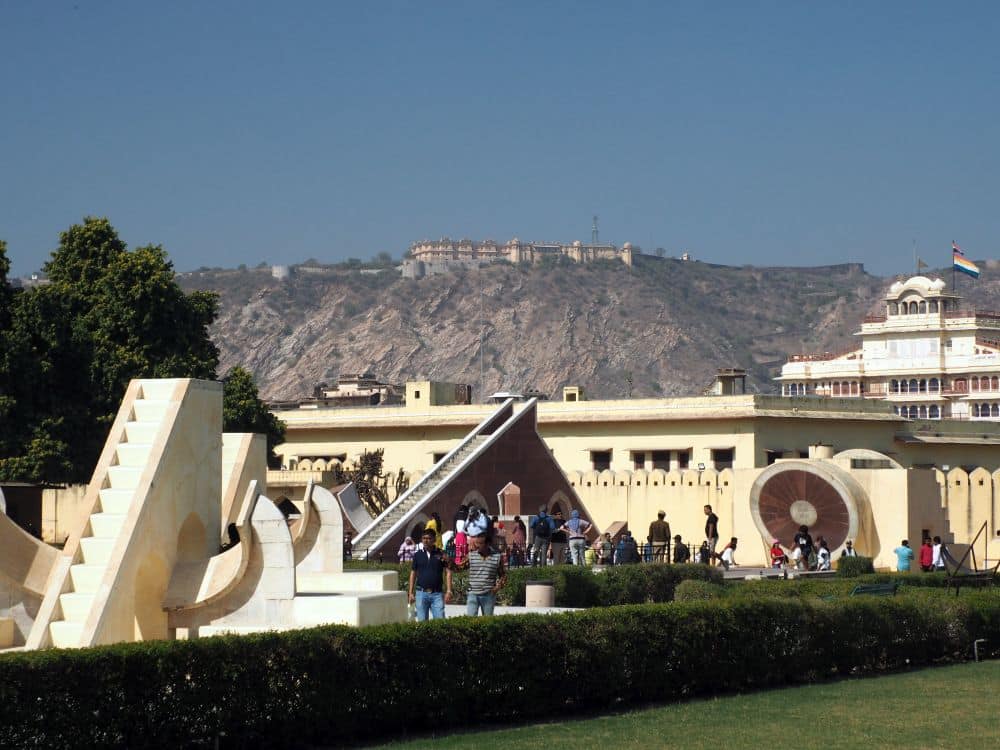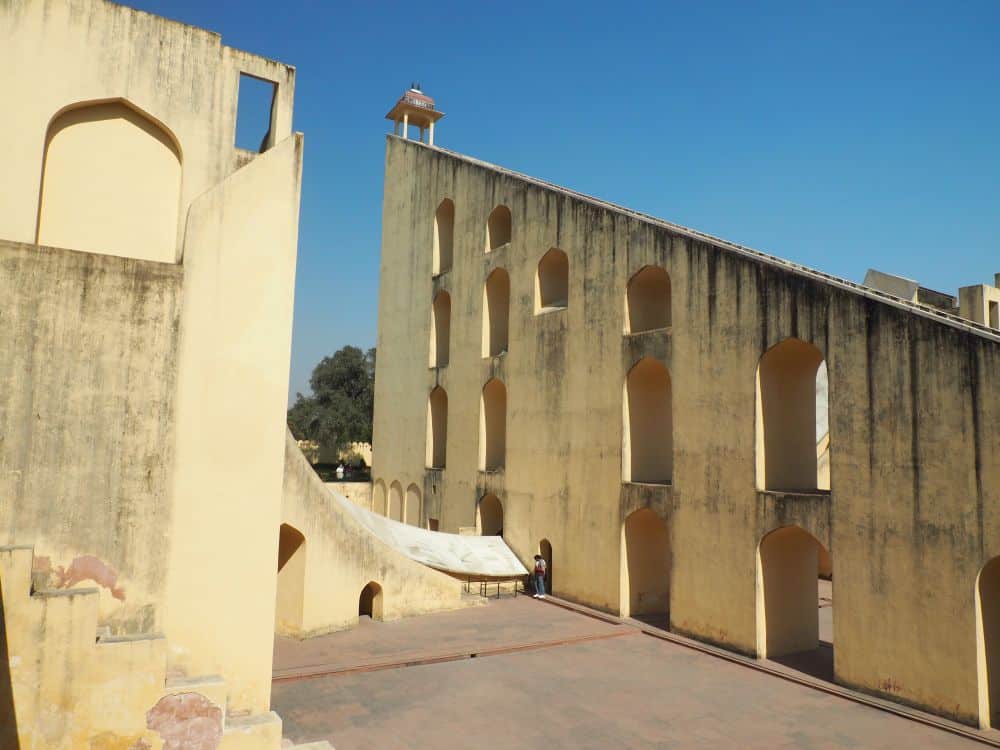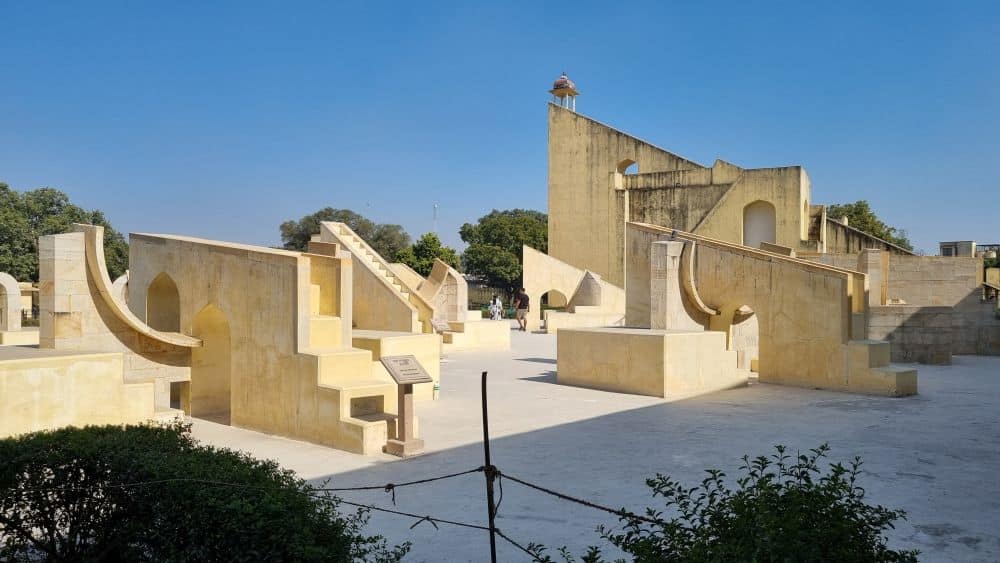The Jantar Mantar, Jaipur
By Rachel Heller
What is the Jantar Mantar, Jaipur?
The Jantar Mantar is an astronomical observatory built out of masonry on a very large scale by the scholar-prince Jai Singh. Jai Singh was born in 1688 and became Raja in 1699, but was particularly interested in astronomy. He studied Hindu astronomers, but also Muslim and European works.

Disclosure: This article contains affiliate links. Making a purchase through an affiliate link will mean a small commission for this website. This will not affect your price. Privacy policy.
Raja Jai Singh was responsible for building five different observatories, starting with the one in Delhi. The one in Jaipur was finished in 1734 and is the largest and most complete. The idea was that if the instruments were large and built of stone, rather than the usual metal ones, they could be more accurate. There are 19 astronomical instruments, all of which could be read with the naked eye. Singh was quite accomplished with his study of astronomy, including work on “rectification of the Calendar and prediction of eclipses” according to a sign at the location.
Why is the Jantar Mantar a UNESCO World Heritage site?
The Jantar Mantar, according to UNESCO, “is an outstanding example of the coming together of observation of the universe, society and beliefs.” It is a culmination of a centuries-long scientific and religious tradition across the globe. It is also a great example of such monumental instrumentation, and some of the instruments are the largest of their kind in the world.

What can you expect on a visit to the Jantar Mantar in Jaipur?
The grounds of the Jantar Mantar are right in the old city, next to the City Palace. It’s not a large place – under two hectares (about 4.5 acres) – with the instruments spread across the lawn. And they are huge! They measure things like the time of day, height of the sun in the sky, the location of various heavenly bodies, and so on.
The most eye-catching of the instruments is the huge Vrihat Samrat Yantra, essentially a sundial to measure the time and length of the day. The informational sign explaining how it works claims that it can tell the time to an accuracy of within two seconds.

The 12 rashivalays look like smaller sundials, but there’s one for each sign of the zodiac. They were used for observing celestial latitude and longitude. Each could be used when that particular sign was on the meridian.
Other instruments measure the altitude of objects in the sky, the length of the day, and other measurements concerning planets and stars. Hemispherical marble bowls show drawings of the entire sky including the paths of the stars and planets.
We visited in the middle of the day. There were a lot of people wandering the grounds, reading the signs explaining each one, and taking lots of selfies. The signs explain what each instrument does in quite some detail. As a non-scientist, though, I still didn’t really understand most of them.

Is the Jantar Mantar in Jaipur worth visiting?
I would say that for the layperson, it’s probably not worth visiting. For anyone interested in astronomy or, for that matter, astrology, it would be very interesting. As I was puzzling out the explanations on the informational signs, I kept thinking how much my two astronomer friends would enjoy this and get far more from it than I did.
While there were some children there when we visited, there really isn’t much here for any child who isn’t interested in astronomy. They would be tempted to climb on the instruments, but it isn’t allowed.
Tips for visiting the Jantar Mantar
If you are interested but don’t know much about astronomy, it might be worth hiring a guide. I saw quite a few who seemed to be able to explain how each instrument works. There are plenty of guides at the entrance – just make sure to ask to see their guide credential. Also, there is a set hourly rate for guides posted near the entrance. Insist on holding to that – don’t get into negotiations. Do add a tip if they did a good job.
Make sure to visit on a sunny day. That’s when you’ll be able to see how some of the instruments work, throwing shadows onto markings that give a measurement.
I’d guess a visit – unless you’re a true enthusiast – won’t take more than about an hour.
While you’re in Jaipur, see some of the other highlights. Jaipur’s old town is a UNESCO site itself, and Amber Fort, outside of the city, is part of the Hill Forts of Rajasthan UNESCO site.
Use the map below to find your accommodations in Jaipur. It is centered on the city palace in Jaipur old city:
Where is the Jantar Mantar, Jaipur?
The Jantar Mantar is in the old city of Jaipur, in the same large block as the City Palace and the Hawa Mahal, which is also a palace. The nearest metro stop is Badi Chaupar. Otherwise you can take a tuk-tuk or taxi to get to the entrance. It’s just a short walk from the selfie-taking crowds in front of the Hawa Mahal.
Jaipur is about a 4-5-hour drive or train ride from Agra and about the same from Delhi. Here’s a good place to book train journeys or buses – it’s what we used. From the railway station in Jaipur, the easiest way to get to the Jantar Mantar and the old city is by metro, which is cheap and quiet and frequent.
Jaipur, as the capital of Rajasthan, also has an international airport, receiving both domestic and international flights.
For more information about the Jantar Mantar in Jaipur, see Incredible India’s tourism website.
Have you been to Jaipur and seen the Jantar Mantar? If so, do you have any additional information or advice about this UNESCO World Heritage site? Please add your comments below!

